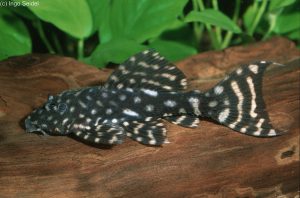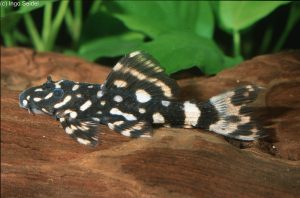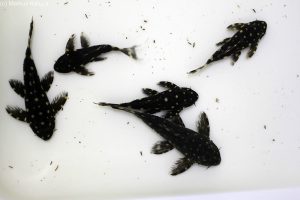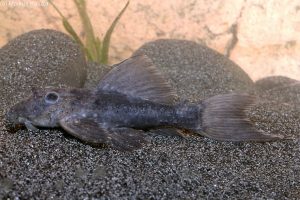Cactus Plecos of the genus Pseudacanthicus enjoy great popularity.
 There are particularly colourful species, such as Pseudacanthicus leopardus, Pseudacanthicus pitanga (L 24), Pseudacanthicus sp. “L 273” or Pseudacanthicus pirarara (L 25), and also the species with white spots on a black base colour. Pseudacanthicus sp. “L 65” is a species that supposedly falls under the latter category, but is it actually so?
There are particularly colourful species, such as Pseudacanthicus leopardus, Pseudacanthicus pitanga (L 24), Pseudacanthicus sp. “L 273” or Pseudacanthicus pirarara (L 25), and also the species with white spots on a black base colour. Pseudacanthicus sp. “L 65” is a species that supposedly falls under the latter category, but is it actually so?
In fact, wild specimens of this species are hard to get, which makes this species rare in the trade. Most animals in the trade are offspring from a few experienced breeders, especially the chairman oft he Catfish Study Group, Mark WALTERS and my good friend and world-wide recognised Pseudacanthicus expert Ole PAULSEN.
 I am currently keeping a small group of these animals again, which I acquired from Mark at the CSG convention in 2020. These individuals are also the reason why I am finally writing this text, because no Pseudacanthicus species that I have ever kept or seen in friends’ homes is so variable. When NUMRICH (1990) found this catfish 31 years ago as a by-catch between Peckoltia species and presented it in DATZ, one of the juveniles showed beautiful large white blotches on a dark background, the second one, which was of similar size, already showed smaller spots on the dark-grey base colour. While in Pseudacanthicus sp. “L 97” the clear pattern of dots only fades a little with age, but remains present, most Pseudacanthicus sp. “L 452” from Peru and P. sp. “Alenquer” show a variance in the pattern: the small, clear dots, which the juvenile animals still had, can blur or join.
I am currently keeping a small group of these animals again, which I acquired from Mark at the CSG convention in 2020. These individuals are also the reason why I am finally writing this text, because no Pseudacanthicus species that I have ever kept or seen in friends’ homes is so variable. When NUMRICH (1990) found this catfish 31 years ago as a by-catch between Peckoltia species and presented it in DATZ, one of the juveniles showed beautiful large white blotches on a dark background, the second one, which was of similar size, already showed smaller spots on the dark-grey base colour. While in Pseudacanthicus sp. “L 97” the clear pattern of dots only fades a little with age, but remains present, most Pseudacanthicus sp. “L 452” from Peru and P. sp. “Alenquer” show a variance in the pattern: the small, clear dots, which the juvenile animals still had, can blur or join.
 In Pseudacanthicus sp. “L 65”, on the other hand, the dots or spots quickly turn grey, or the coat of dots disappears almost completely. Those who have already kept this species themselves know that specimens, which can be really pretty when young, can quickly become a “grey mouse”. It is also remarkable that not all young animals have these beautiful large white blotches like the animal from DATZ. Even in one clutch the variance is quite large. There can be anything from large blotches to a fine pattern of dots or hardly any dots at all. When reaching a size of 10.0 cm TL, the large spots disappeared at the very latest in the last specimen I’ve kept. SEIDEL & EVERS (2005) also pointed out in Catfish Atlas 2 that this species is very variable.
In Pseudacanthicus sp. “L 65”, on the other hand, the dots or spots quickly turn grey, or the coat of dots disappears almost completely. Those who have already kept this species themselves know that specimens, which can be really pretty when young, can quickly become a “grey mouse”. It is also remarkable that not all young animals have these beautiful large white blotches like the animal from DATZ. Even in one clutch the variance is quite large. There can be anything from large blotches to a fine pattern of dots or hardly any dots at all. When reaching a size of 10.0 cm TL, the large spots disappeared at the very latest in the last specimen I’ve kept. SEIDEL & EVERS (2005) also pointed out in Catfish Atlas 2 that this species is very variable.
 HARDMAN (2015) classified Pseudacanthicus sp. “L 65” with P. sp. “Alenquer” and P. sp. “L 97”, but how closely these three types are really related to each other is still scientifically unclear. While Pseudacanthicus sp. “Alenquer” and P. sp. “L 97” are regularly imported, no new Pseudacanthicus sp. “L 65” are currently entering the hobby. Current information about the variance of wildcaught specimens is therefore not available at present. The propagation and spread of these specimens are still very welcome, even if they aren’t colour wonders.
HARDMAN (2015) classified Pseudacanthicus sp. “L 65” with P. sp. “Alenquer” and P. sp. “L 97”, but how closely these three types are really related to each other is still scientifically unclear. While Pseudacanthicus sp. “Alenquer” and P. sp. “L 97” are regularly imported, no new Pseudacanthicus sp. “L 65” are currently entering the hobby. Current information about the variance of wildcaught specimens is therefore not available at present. The propagation and spread of these specimens are still very welcome, even if they aren’t colour wonders.
Text: Markus KALUZA – Pictures: Markus KALUZA and Ingo SEIDEL
Literature:
- HARDMAN M., 2015. Typhoons, spiny monsters and scarlet cactus: a preliminary review of Pseudacanthicus catfishes (Siluriformes: Loricariidae). Journal of the Catfish Study Group Vol. 16 (4): 18-31.
- NUMRICH, R., 1990. Neu importiert Harnischwels L65. DATZ, 43(7): 392.
- SEIDEL I., EVERS H. G., 2005. Wels Atlas Bd. 2: 91-93.
- WALTERS M., 2018. Spawning Pseudacanthicus sp. L065 – The blizzard cactus pleco. Journal of the Catfish Study Group, 19(2): 8-10.